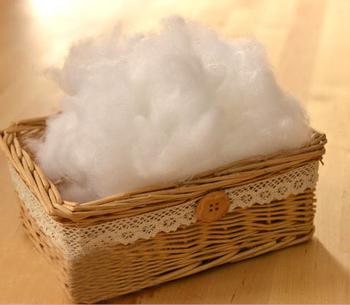It’s not a secret to anyone that fillers are used to give shape to soft toys. Now there are a large number of them. They differ among themselves in properties, texture, density, etc. Not many people know how to choose the right filler, so we will consider the most common of them today. Let's find out what modern needlewomen stuff stuffed with soft toys with.
Synthetic winterizer
A well-known synthetic material that is widely used in needlework. The synthetic winterizer, as a filler for toys, is used quite often. Its undoubted advantage is its light texture, as well as its synthetic composition, which significantly reduces the possibility of allergies. But it is worth remembering that the synthetic winterizer often gets off after washing, forming lumps. This must be taken into account, especially if this filler is in toys that children often play.
To use a synthetic winterizer as a filler for soft toys, it must be crushed into small pieces for even distribution throughout the product. Of course, this process takes time. But the result is a soft toy that, when squeezed, instantly restores its original shape. Not every filler can boast of such a property. However, one should not forget that a low-quality synthetic winterizer may contain harmful substances in the composition, contact with which is sometimes very dangerous for humans.
Fluff and feather
A natural filler in the form of wool, fluff, feathers will not be the best option for stuffing soft toys. Although these materials are of natural origin and get them naturally. Naturally, a soft toy with wool or fluff inside will keep heat much longer. This is very important when it comes to items that children like to sleep with. Down and feather is a very lightweight filler for stuffed animals with a rather pleasant texture.
But very often, such fillers get stuck in toys, forming lumps that are quite difficult to return to a paramount state. Such problems are observed after washing. Drying a toy with such a filler is a rather difficult process that requires a long time. Often fluff, feather and wool cause allergies, and are also attacked by moths and ticks. These fillers are well suited for knitted toys, as well as products with which a person does not have constant contact.
Holofiber
A modern synthetic filler ideal for making toys. It is sold in the form of dense balls, which are quite light in weight. With its help, you can easily stuff any toy - a holofiber will easily fill the entire space. Often, when choosing a filler, the question arises of how to fill the toy so that after washing it retains its shape. With the advent of holofiber, this problem is considered solved.

The material dries quickly, does not lose shape, does not stray into lumps, which is so important for soft toys. The hypoallergenic composition of holofiber balls makes it the number one filler. With its help, many unusual crafts were made. For many modern craftswomen, this filler for toys has become a favorite, and all due to a number of advantages over other materials for stuffing. The number of holofiber can be used to adjust the density of the product; in the manufacture of large-sized toys, small balls of filler are combined to form one large element. The composition of this wonderful filler includes polyester, which, as you know, does not absorb extraneous odors, and is also a non-toxic fiber.
Foam rubber
The material that is usual and familiar to all is foam rubber, which can be found on sale in any market and in a hardware store. It is of various thicknesses. To work with this material, you need a clerical knife or a red-hot wire, because it is quite difficult to cut it. Foam rubber is a filler with which stuffed soft toys of uniform shape, requiring special rigidity. The most popular among these items are cubes and pyramids.
Foam rubber is a quick-drying material that will not cause allergies. You can use this filler, previously cutting it into small pieces. But this type of packing will not last long, it will begin to crumble, stick together and stray into lumps. If you use foam rubber of large thickness, it is worth it to dry thoroughly after washing, to avoid dampness and mustiness.
Natural fillers
To increase tactile sensations , packing from cereals, seeds, seeds, legumes, pasta, sand and even herbs is often used. Natural filler for toys can be combined with synthetic materials, or completely stuff the product with them. Before using the components, it is recommended to fry in the oven. In no case should you wash toys with such fillers. But what if you can’t do without washing? This problem is solved using a bag in which the filler is placed, and a snake is sewn on the toy itself.
Herbs, as a filler for toys, are used to add flavor to the product. Use only well-dried plants, which are necessarily sutured into a bag. But, unfortunately, the life of such "fragrant" toys is quite short.
Granulate
Ball-shaped granules, which are used as a filler for toys, are called granules. Balls come in three types: glass, metal and plastic. Granulate is the stuff of stuffed soft toys for weighting and increasing stability. Most often, this filler is found in the extremities of teddy animals, as well as in the tummy area. Textured granulate is considered useful for the development of motor skills in young children. However, glass and metal balls are forbidden to be used in toys because of the risk of them falling out through the seams. To avoid such cases, you need to put the balls in special nets or bags, but even this will not be a guarantee of security.
The antistress filler for toys, which is a porous polystyrene balls, is very popular. Almost weightless toys filled with such elements are recommended for children, pregnant women and even adults.